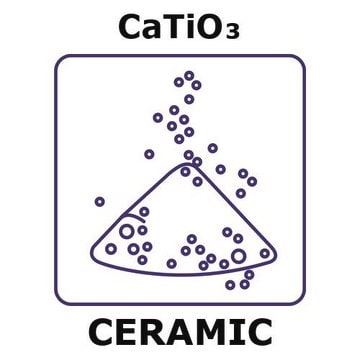396141
Strontium titanate
powder, 99%
Synonym(s):
Strontium titanium trioxide
Sign Into View Organizational & Contract Pricing
Select a Size
All Photos(3)
Select a Size
Change View
About This Item
Linear Formula:
SrTiO3
CAS Number:
Molecular Weight:
183.49
EC Number:
MDL number:
UNSPSC Code:
12352300
PubChem Substance ID:
NACRES:
NA.23
Recommended Products
assay
99%
form
powder
reaction suitability
reagent type: catalyst
core: titanium
mp
2060 °C (lit.)
density
4.81 g/mL at 25 °C (lit.)
SMILES string
[Sr++].[O-][Ti]([O-])=O
InChI
1S/3O.Sr.Ti/q;2*-1;+2;
InChI key
VEALVRVVWBQVSL-UHFFFAOYSA-N
Looking for similar products? Visit Product Comparison Guide
Related Categories
Storage Class
11 - Combustible Solids
wgk_germany
WGK 3
flash_point_f
Not applicable
flash_point_c
Not applicable
ppe
Eyeshields, Gloves, type N95 (US)
Choose from one of the most recent versions:
Already Own This Product?
Find documentation for the products that you have recently purchased in the Document Library.
Customers Also Viewed
Archana Pandey et al.
ACS nano, 7(1), 117-125 (2012-12-04)
Novel PMMA-STO-CNT matrices were created by opened-tip vertically aligned multiwalled carbon nanotubes (VA-MWCNTs) with conformal coatings of strontium titanate (STO) and poly(methyl methacrylate) (PMMA). Emission threshold of 0.8 V/μm was demonstrated, about 5-fold lower than that of the as-grown VA-MWCNTs.
Qiang Xu et al.
Ultramicroscopy, 111(7), 912-919 (2011-06-15)
The knowledge of the valence electron distribution is essential for understanding the properties of materials. However this information is difficult to obtain from HREM images because it is easily obscured by the large scattering contribution of core electrons and by
L Avilés Félix et al.
Nanotechnology, 23(49), 495715-495715 (2012-11-17)
The transport properties of ultra-thin SrTiO(3) (STO) layers grown over YBa(2)Cu(3)O(7) electrodes were studied by conductive atomic force microscopy at the nano-scale. A very good control of the barrier thickness was achieved during the deposition process. A phenomenological approach was
Ralf Moos et al.
Sensors (Basel, Switzerland), 11(4), 3439-3465 (2011-12-14)
Resistive oxygen sensors are an inexpensive alternative to the classical potentiometric zirconia oxygen sensor, especially for use in harsh environments and at temperatures of several hundred °C or even higher. This device-oriented paper gives a historical overview on the development
Troy K Townsend et al.
ACS nano, 6(8), 7420-7426 (2012-07-24)
SrTiO(3) (STO) is a large band gap (3.2 eV) semiconductor that catalyzes the overall water splitting reaction under UV light irradiation in the presence of a NiO cocatalyst. As we show here, the reactivity persists in nanoscale particles of the
Our team of scientists has experience in all areas of research including Life Science, Material Science, Chemical Synthesis, Chromatography, Analytical and many others.
Contact Technical Service







